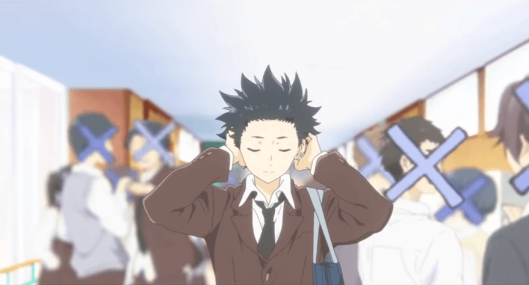Portraying themes of friendship and redemption rather than romance cliches, Koe no Katachi (A Silent Voice) tackles the complexities of life and the struggle to fix fragile ties in a friendship.

Synopsis
Nishimiya Shoko, a deaf girl, transfers into Ishida Shoya’s elementary school class. Tired of constantly helping her, the class starts to bully Nishimiya, especially Ishida. However, the bullying intensifies, turning on Ishida instead. Nishimiya tries to help, but he retaliates and they get into a fight, resulting in Nishimiya transferring schools and Ishida being isolated by his classmates and friends. The two do not meet after, but in middle school, Ishida decides to meet Nishimiya again to make up for past misdeeds and to become her friend.
Opening Plot

We see Ishida in the present, getting his pay, withdrawing his the money from his bank account, and crossing out days off his calendar.
A flashback to the past explains Ishida’s situation and his complex behavior in his elementary school days. Ishida initially stood up for Nishimiya when some classmates were criticising her, even suggesting that she should try harder to communicate with the class. However, when Nishimiya indicated that she wanted to be his friend, he turned hostile and began bullying Nishimiya instead, the bullying becoming more extreme as Ishida started snatching and destroying her expensive hearing aids.
Ishida’s complex and extreme behaviour in the past was baffling to me as he switched sides so quickly, and even became the greatest bully. After bullying Nishimiya and being isolated by his elementary school classmates, Ishida continues being alone in middle school. He sees ‘crossed-out’ faces, symbolizing the distance he places between himself and others, and his unwillingness to reach out and make new friends. Overwhelmed by guilt caused by his past actions, he plans to commit suicide.
The Theme of Redemption

The movie portrays Ishida’s maturity as he learns that suicide does not absolve the guilt he feels. He keeps Nishimiya’s ‘For Conversation’ notebook to return to her and learns sign language to communicate with her. Meeting Nishimiya at a sign language school by chance, Ishida tries to befriend her. However, he faces opposition from Yuzuru, a student from the sign language school, who sternly tells him to stop coming to sign language class if he just wanted to assuage his conscience by doing so.
This is deeply disconcerting as it portrays redemption as an ultimately selfish act – doing good not for the betterment of others, but for personal gratification and comfort.
In spite of this, Ishida’s quest for redemption leads to his eventual befriending of Nishimiya. His growth evident in how he faces others – no longer does he see ‘crossed out’ faces, but now has the courage to move on and cross the boundary he draws between himself and others. Ishida’s social circle gradually increases, revisiting friendships with his middle school classmates.
Overall Critique

As a movie adaptation of a manga, some parts feel rushed. For example, the ‘strange’ group’s trip, involving classmates both new and old, to the amusement park is rather disjointed. While the trip demonstrates how Ishida’s social circle has expanded, the group’s formation is quite odd as Ishida is not really portrayed to be friends with some of them. Nevertheless, this is inevitable as some of the original plot in the manga is removed, taking into account the duration of the movie.
While some of the side characters attempt at redeeming themselves, this is usually not completely successful. Ueno is the second most complex character, with the first being Ishida. As an elementary school classmate, she had previously contributed to Nishimiya’s bullying and lied to the teacher that Ishida was the sole bully. Although she wants to help stand up for Ishida as an apology of her past betrayal, she still hates Nishimiya. The movie also touches on the flaws of Ishida’s other elementary school classmates, showing how each character faces certain conflicts which obstruct their path to redemption.
Despite the drama, Koe no Katachi does not forgo humour. The funniest parts are Yuzuru’s identity, Nyan Nyan Cafe and Nishimiya’s failed confession, garnering the most laughter from the audiences in the theatre I was in.
All in all, Koe no Katachi is thought-provoking, reminding audiences to come to terms with our pasts and continue moving forward. The film’s complex cast of characters mirror our own individual complexity, and beautifully depicts the struggle of friendship and its fragility.
Watch the trailer here: https://youtu.be/9aRexOtovXY
Note: The names I have used are the family names of the characters because they are more commonly referred to that way in the movie, with the exception of Yuzuru.
Have another anime film that you’d like to recommend? Let us know over on our Facebook page!


